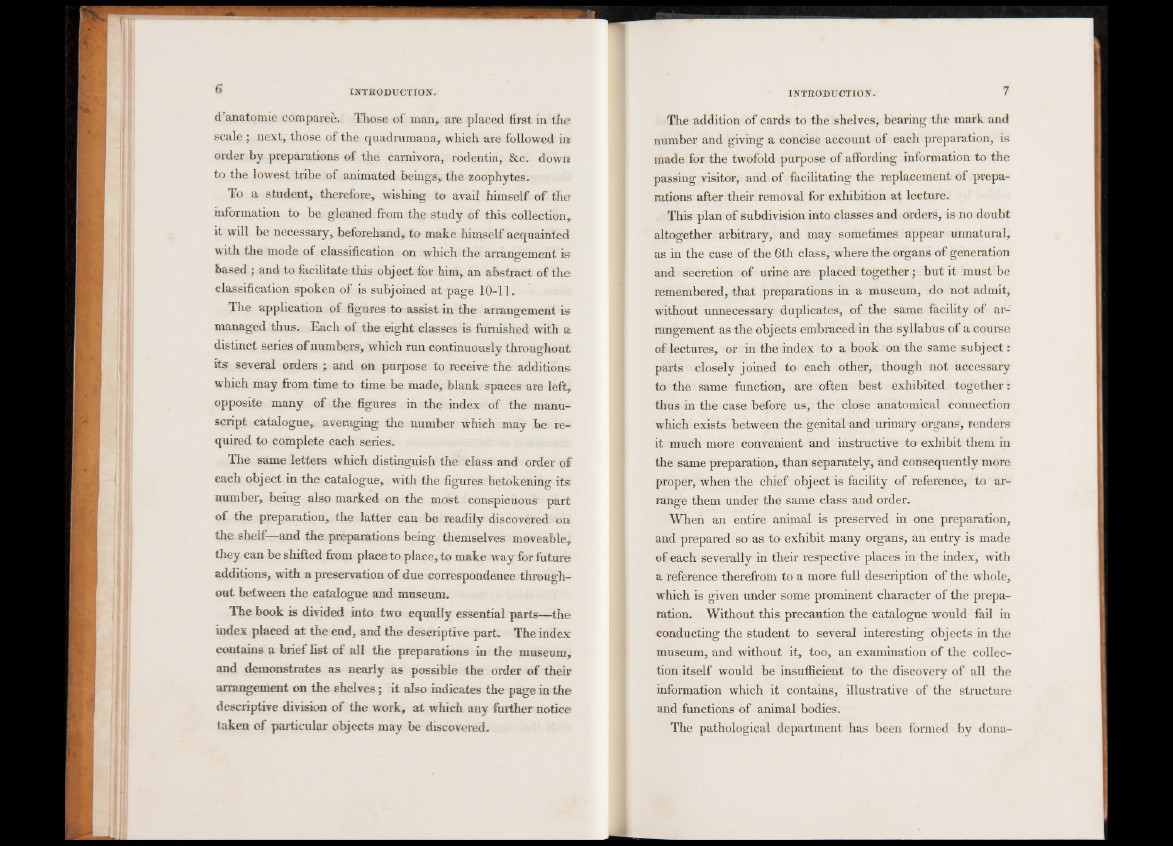
d’anatomie comparee. Those of man, are placed first in the
scale ; next, those of the quadrumana, which are followed in
order by preparations of the carnivora, rodentia, &c. down
to the lowest tribe of animated beings, the zoophytes.
To a student, therefore, wishing to avail himself of the
information to be gleaned from the study of this collection,
it will be necessary, beforehand, to make himself acquainted
with the mode of classification on which the arrangement is
based j and to facilitate this object for him, an abstract of the
classification spoken of is subjoined at page 10-11.
The application of figures to assist in the arrangement is
managed thus. Each of the eight classes is furnished with a
distinct series of numbers, which run continuously throughout
its several orders ; and on purpose to receive the additions
which may from time to time be made, blank spaces are left,
opposite many of the figures in the index of the manuscript
catalogue, averaging the number which may be required
to complete each series.
The same letters which distinguish the class and order of
each object in the catalogue, with the figures betokening its
number, being also marked on the most conspicuous part
of the preparation, the latter ean be readily discovered on
the shelf—and the preparations being themselves moveahle,
they can be shifted from place to place, to make way for future
additions, with a preservation of due correspondence throughout
between the catalogue and museum.
The book is divided into two equally essential parts—the
index placed at the end, and the descriptive part. The index
contains a brief list of all the preparations in the museum,
and demonstrates as nearly as possible the order of their
arrangement on the shelves; it also indicates the page in the
descriptive division of the work, at which any further notice
taken of particular objects may be discovered.
The addition of cards to the shelves, bearing the mark and
number and giving a concise account of each preparation, is
made for the twofold purpose of affording information to the
passing visitor, and of facilitating the replacement of preparations
after their removal for exhibition at lecture.
This plan of subdivision into classes and orders, is no doubt
altogether arbitrary, and may sometimes appear unnatural,
as in the case of the 6th class, where the organs of generation
and secretion of urine are placed together ; but it must be
remembered, that preparations in a museum, do not admit,
without unnecessary duplicates, of the same facility of arrangement
as the objects embraced in the syllabus of a course
of lectures, or in the index to a book on the same subj ect:
parts closely joined to each other, though not accessary
to the same function, are often best exhibited together:
thus in the case before us, the close anatomical connection
which exists between the genital and urinary organs, renders
it much more convenient and instructive to exhibit them in
the same preparation, than separately, and consequently more
proper, when the chief object is facility of reference, to arrange
them under the same class and order.
When an entire animal is preserved in one preparation,
and prepared so as to exhibit many organs, an entry is made
of each severally in their respective places in the index, with
a reference therefrom to a more full description of the whole,
which is given under some prominent character of the preparation.
Without this precaution the catalogue would fail in
conducting the student to several interesting objects in the
museum, and without it, too, an examination of the collection
itself would be insufficient to the discovery of all the
information which it contains, illustrative of the structure
and functions of animal bodies.
The pathological department has been formed by dona